|
Aluminium
(Al) toxicity is the most common cause of growth reduction on strongly acid
soils. Aluminium is the most abundant metal in the earth’s crust, but its
solubility at neutral to alkaline pH
is very low. However, below about pH 5.0 (measured in water), Al solubility
increases rapidly and may reach toxic
concentrations. Solution culture experiments have shown that sweetpotato will
grow normally at pH values as low as 4.0 in the absence of Al. Therefore, in the
field, sweetpotato crops probably encounter problems of Al toxicity before
suffering any direct effects of low pH.
Sweetpotato is considered to be
moderately tolerant of Al. It was also
found to be more tolerant of soil acidity than taro, yam, tobacco, maize, green
bean or soybean, but less tolerant than cassava.
The primary effect of Al toxicity is to
reduce root development (Figures a-c). Roots appear short and thickened, with
short laterals, and may be discoloured yellow to brown. Root hair development is
suppressed. Where the Al concentration increases with soil depth, the downward
extension of the roots may be restricted, resulting in a very shallow root
system.
In addition to poor growth and stunted
appearance, a number of symptoms may appear in the tops as a result of poor root
development, depending on which secondary factor is most limiting. Symptoms of
water stress are common. As Al in the soil solution inhibits the uptake of Ca
and Mg by roots, symptoms of Ca or Mg deficiency may develop. In addition, the
solubility of P is reduced in the presence of high concentrations of Al, so that
P deficiency is often associated with Al toxicity .
|
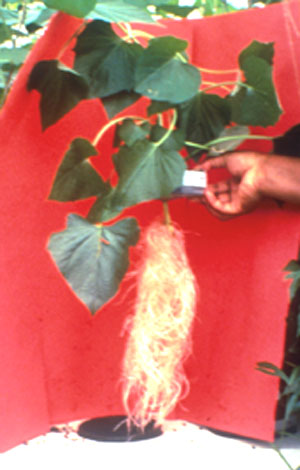
(a)
0 µM Al
|
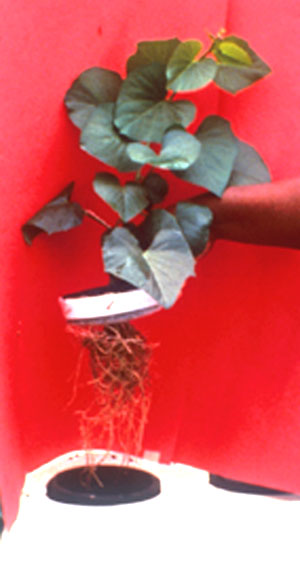
(b)
25 µM Al
|
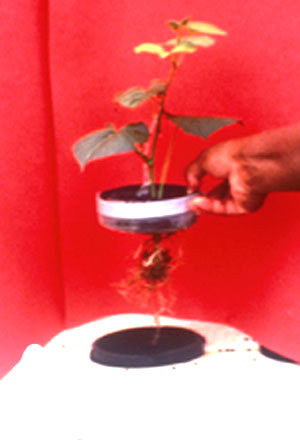
(c)
50 µM Al
|
| Fig. a-c. Root
growth comparison in sweetpotato cv. Meriken grown
in nutrient solution with Aluminium (V.
Ila'ava). |
As mentioned above, Al toxicity is often
associated with the expression of other nutritional disorders, such as a
deficiency of Ca, Mg or P. Carefully uprooting plants may reveal a root system
of limited extent, and brown in appearance.
Aluminium toxicity is best diagnosed by
testing the soil. Soils with a pH below 5.0 (measured in 1:5 soil:water) are at
risk of Al toxicity, and in soils below pH 4.5 (other than organic soils), Al is
likely to severely reduce sweetpotato production.
Tests for exchangeable Al and Al
saturation may be useful. Abruna et al. (1979) found that Al saturation
correlated well with the response of sweetpotato yields to liming on several
tropical oxisols and ultisols, with the greatest beneficial effect of lime on
those soils with greater than 60% Al saturation. Liming a soil with 35% Al
saturation resulted in only a 10% yield increase. Ila’ava et al. (1996)
demonstrated that the tolerance of sweetpotato to solution Al is greatly
increased in the presence of high concentrations of Ca, and it may be necessary
to take Ca availability into account when using soil tests to predict crop
response to Al.
Cultural control
Correction requires elevation of the soil pH, through the
incorporation of lime or dolomite into the soil. In addition, maintenance of
high soil organic matter levels through the return of crop residues, cover
cropping, or mulching will help as components in the organic matter are capable
of binding free Al into non-toxic complexes. Organic matter also helps to slow
the rate of acidification of the soil, which may result from sequential
cropping. Choosing nitrate fertilisers instead of urea or ammonium fertilisers
may also reduce acidification.
Phosphate forms insoluble complexes with Al. Some of the
beneficial effect of adding P fertilisers to acidic volcanic ash soils appears
to result from decreasing solution Al concentrations.
Host plant resistance
Sweetpotato cultivars have been shown to vary in their
tolerance and sensitivity to
high concentrations of Al. Cultivars
which yield well under acid soil conditions may be selected.
Abruna, F.,
Vincente-Chandler, J., Rodriguez, J., Badillo, J. and Silva, S. 1979. Crop
response to soil acidity factors in ultisols and oxisols in Puerto Rico. V.
Sweet potato. Journal of the Agricultural University of Puerto Rico 63, 250-267.
Abruna-Rodriguez,
F., Vincente-Chandler, J., Rivera, E. and Rodriguez, J. 1982. Effect of soil
acidity factors on yields and foliar composition of tropical root crops. Soil
Science Society of America J. 46, 1004-1007.
Blamey,
F.P.C., Vermeulen, W.J. and Chapman, J. 1984. Inheritance of boron status in
sunflower. Crop Science 24:43-46.
Ila’ava,
V.P., Blamey, F.P.C. and Asher, C.J. 1996. Sensitivity of sweet potato lines
to Ca and Al stress in solution culture. In: Craswell, E.T. Asher, C.J. and O’Sullivan,
J.N. (eds.) ACIAR Proceedings No.65: Mineral nutrient disorders of root crops in
the Pacific. pp 53-57.
Munn, D.A.
and McCollum, R.E. 1976. Solution culture evaluation of sweet potato cultivar
tolerance to aluminium. Agronomy Journal 68, 989-991.
O’Sullivan,
J.N., Asher, C.J. and Blamey, F.P.C. (1997) Nutrient Disorders of Sweet Potato.
ACIAR Monograph No. 48, Australian Centre for International Agricultural
Research, Canberra, 136 p.
Ritchey, K.D.,
Wright, R.J., Baligar, V.C. and Murrmann, R.P. 1991. Evaluating sweet potato
tolerance to aluminium toxicity: comparison of rapid test method and field
results. In: Wright, R.J., Baligar, V.C. and Murrmann, R.P. (eds.) Developments
in Plant and Soil Sciences Vol. 45: Plant-soil interactions at low pH. Kluwer
Acad. Publ., Dordrecht, pp 939-945.
Sangalang,
J.B. and Bouwkamp, J.C. 1988. Selection of sweet potato for tolerance to
aluminium toxicity: screening procedures and field tests. Journal of the
American Society for Horticultural Science 113(2), 227-281.
Contributed
by:
Jane O'Sullivan |
Characteristics
and occurrence
Symptoms
Confusion
with other symptoms
Diagnostic
tests
Management
References
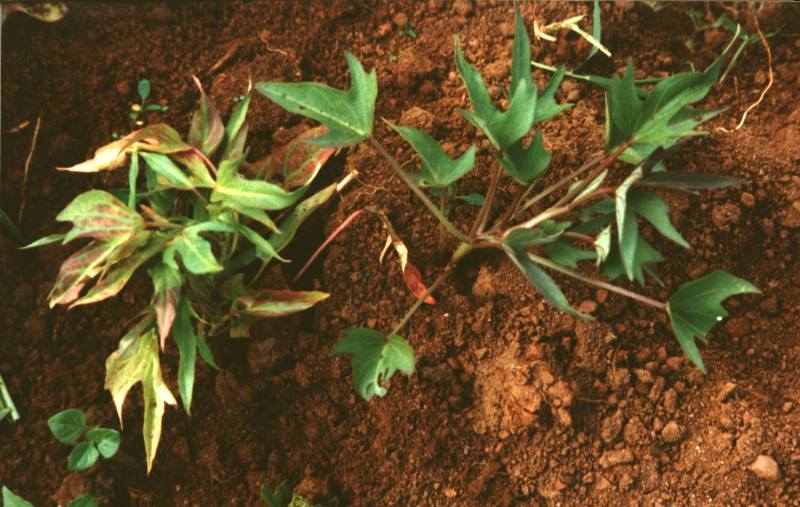
Stunted plants, with chlorosis and bronzing present on one variety
but not the other (J. Low).
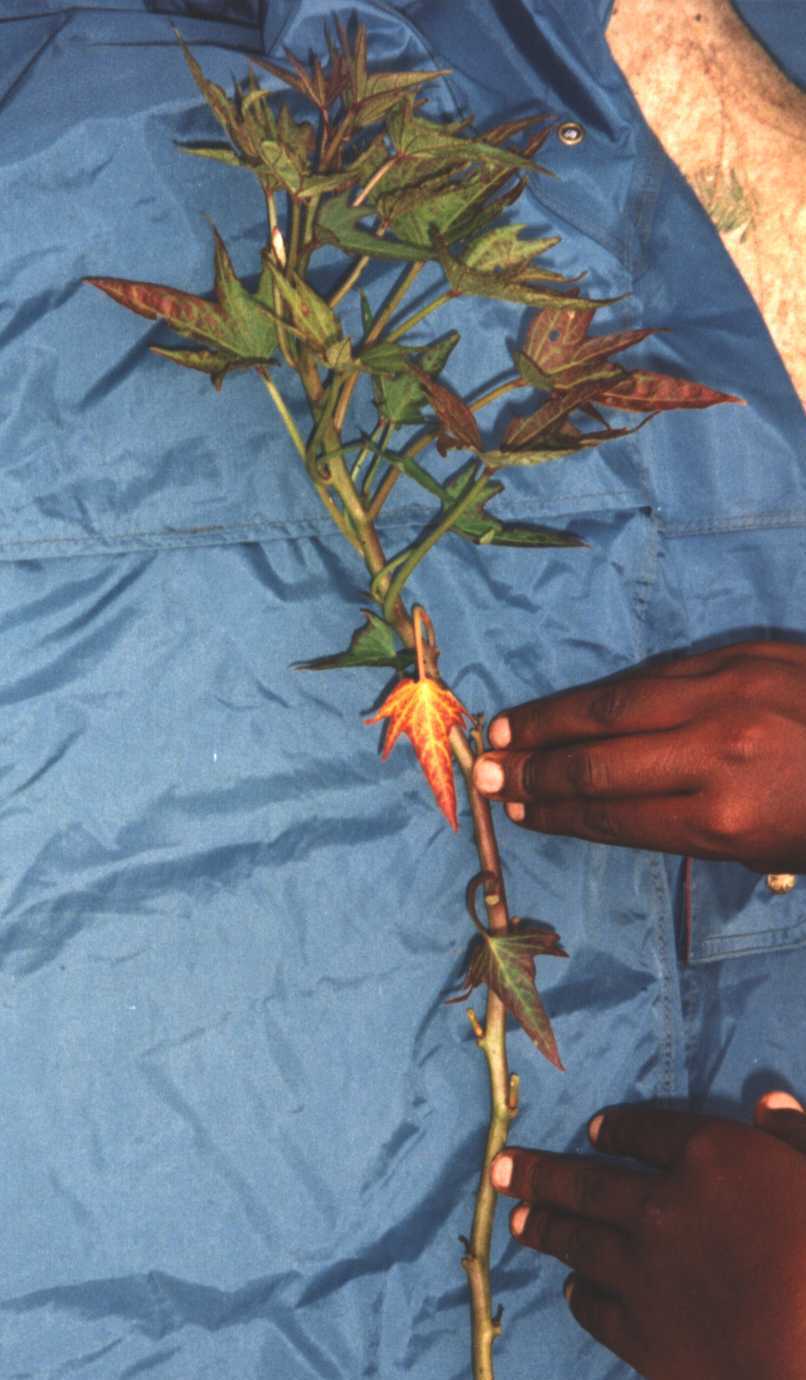
Symptoms of phosphorus deficiency (reddening, yellowing and shedding
of oldest leaves) on a severely stunted plant (J. Low) |

